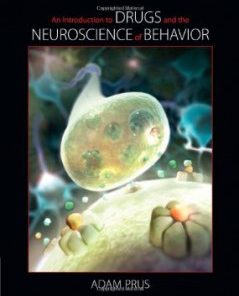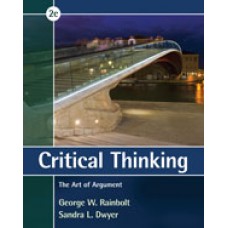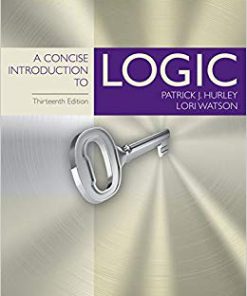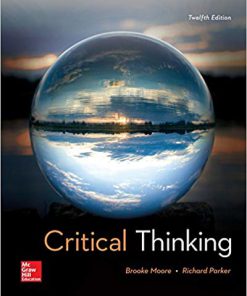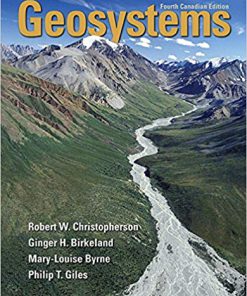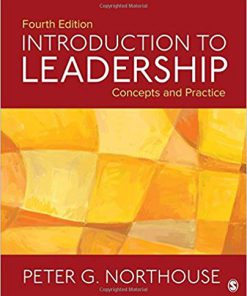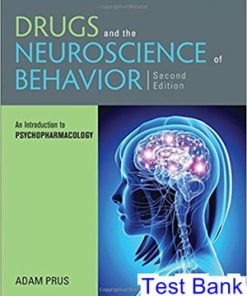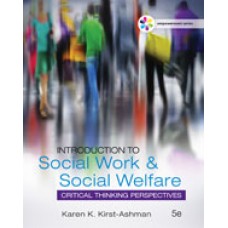Test Bank for The Art of Reasoning An Introduction to Logic and Critical Thinking, Fourth Edition
$35.00 Original price was: $35.00.$26.50Current price is: $26.50.
Test Bank for The Art of Reasoning An Introduction to Logic and Critical Thinking, Fourth Edition
Test Bank for The Art of Reasoning An Introduction to Logic and Critical Thinking, Fourth Edition
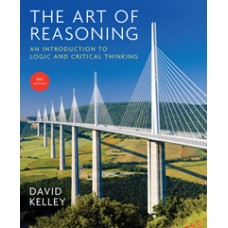
Product details:
- ISBN-10 : 0393930785
- ISBN-13 : 978-0393930788
- Author: David Kelley
Students learn logic by practicing it―by working through problems, analyzing existing arguments, and constructing their own arguments in plain language and symbolic notation. The Art of Reasoning not only introduces the principles of critical thinking and logic in a clear, accessible, and logical manner―thus practicing what it preaches―but it also provides ample opportunity for students to hone their skills and master course content.
Table of contents:
Introduction 1
Part 1 Language and Reasoning
Chapter 1 Classification
1.1 Concepts and Referents 9
1.2 Rules of Classification 13
1.2A Consistent Principle 13
1.2B Essential Attributes 15
1.3 Levels of Organization 18
Summary 22
Additional Exercises 22
Chapter 2 Definitions
2.1 The Functions of a Definition 26
2.2 Rules for Definitions 28
2.3 Constructing Definitions 36
Summary 42
Additional Exercises 42
Chapter 3 Propositions
3.1 Propositions and Word Meaning 48
3.1A Connotations 49
3.1B Metaphors 50
3.2 Propositions and Grammar 52
3.2A Propositions and Sentence Structure 52
3.2B Connectives 55
3.2C Restrictive and Nonrestrictive Clauses 57
3.2D Noun Clauses 60
Summary 63
Additional Exercises 63
Chapter 4 Argument Analysis
4.1 Elements of Reasoning 68
4.1A Premise, Conclusion, and Argument 68
4.1B Recognizing Arguments 69
4.2 Diagramming Arguments 73
4.3 Evaluating Arguments 79
4.4 Induction and Deduction 82
4.5 Implicit Premises 88
4.6 Distilling Arguments 91
Summary 97
Additional Exercises 98
Chapter 5 Fallacies
5.1 Subjectivist Fallacies 104
5.1A Subjectivism 104
5.1B Appeal to Majority 106
5.1C Appeal to Emotion 106
5.1D Appeal to Force (Argumentum ad Baculum) 108
5.2 Fallacies Involving Credibility 111
5.2A Appeal to Authority (Argumentum ad Verecundiam) 111
5.2B Ad Hominem 113
5.3 Fallacies of Context 116
5.3A False Alternative 117
5.3B Post Hoc 118
5.3C Hasty Generalization 118
5.3D Accident 120
5.3E Slippery Slope 121
5.3F Composition and Division 123
5.4 Fallacies of Logical Structure 127
5.4A Begging the Question (Circular Argument) 127
5.4B Equivocation 128
5.4C Appeal to Ignorance (Argumentum ad Ignorantiam) 130
5.4D Diversion 131
Summary 135
Additional Exercises 136
Part 2 Deductive Logic
Chapter 6 Categorical Propositions
6.1 Standard Form 145
6.1A Components of Categorical Propositions 145
6.1B Translating into Standard Form 148
6.2 The Square of Opposition 151
6.2A Contraries 152
6.2B Contradictories 152
6.2C Subalternates 153
6.2D Subcontraries 154
6.3 Existential Import 155
6.4 Venn Diagrams 158
6.5 Immediate Inference 163
6.5A Conversion 163
6.5B Obversion 166
6.5C Contraposition 170
Summary 174
Additional Exercises 175
Chapter 7 Categorical Syllogisms
7.1 The Structure of a Syllogism 179
7.2 Validity 184
7.3 Enthymemes 186
7.4 Rules of Validity 187
7.4A Distribution 187
7.4B The Rules 190
7.4C Enthymemes and Rules 196
7.5 Venn Diagrams 198
7.5A Diagramming Syllogisms 198
7.5B Enthymemes and Venn Diagrams 203
7.5C Venn Diagrams and Existential Import 207
Summary 214
Additional Exercises 214
Chapter 8 Reasoning with Syllogisms
8.1 Disjunctive Syllogisms 220
8.2 Hypothetical Syllogisms 225
8.2A Hypothetical Propositions 225
8.2B Forms of Hypothetical Syllogism 228
8.3 Distilling Deductive Arguments 233
8.3A Identifying the Form of a Syllogism 233
8.3B Nonstandard Quantifiers 237
8.4 Extended Arguments 242
8.4A Categorical Syllogisms in Extended Arguments 243
8.4B Hypothetical Syllogisms in Extended Arguments 245
8.4C Extended Arguments with Elements of Different Types 246
8.4D Compound Components 248
8.4E Distilling an Extended Argument 250
Summary 253
Additional Exercises 254
Chapter 9 Propositional Logic-Propositions
9.1 Connectives 261
9.1A Conjunction, Negation, and Disjunction 262
9.1B Conditional and Biconditional 266
9.1C Truth Functions 271
9.2 Statement Forms 275
9.3 Computing Truth Values 282
9.4 Formal Properties and Relationships 287
9.4A Tautologies, Self-Contradictions, and Contingencies 287
9.4B Equivalence, Contradiction, and Consistency 289
Summary 297
Additional Exercises 298
Chapter 10 Propositional Logic-Arguments
10.1 Truth Table Test of Validity 301
10.2 Truth Table Test: Short Form 306
10.3 Proof 311
10.3A Rules of Inference 311
10.3B Rules of Inference (Continued) 316
10.3C Constructing a Proof 322
10.4 Equivalence 329
10.4A Rules of Equivalence 330
10.4B Rules of Equivalence (Continued) 335
10.5 Conditional Proof and Reductio ad Absurdum 341
10.5A Conditional Proof 341
10.5B Reductio ad Absurdum 344
Summary 351
Additional Exercises 352
Chapter 11 Predicate Logic
11.1 Singular and Quantified Statements 361
11.1A Singular Statements 361
11.1B Quantified Statements 364
11.2 Categorical Statements 366
11.3 Quantifier Scope and Statement Forms 371
11.3A Compound Statements Within the Scope of a Quantifier 371
11.3B Combining Quantified Statements 373
11.4 Proof 377
11.4A Using Propositional Rules 377
11.4B Equivalence Rule: Quantifier Negation 379
11.4C Inference Rules 382
11.4D Strategies for Proof 388
11.4E Conditional Proof and Reductio ad Absurdum 393
11.5 Relations and Multiple Quantification 397
11.5A Relations 397
11.5B Overlapping Quantifiers 399
11.5C Proof with Relational Statements 403
Summary 409
Additional Exercises 410
Part 3 Inductive Logic
Chapter 12 Inductive Generalizations
12.1 Generalizing 417
12.1A Three Rules for Generalizing 419
12.2 Causality 423
12.3 Agreement and Difference 425
12.4 Concomitant Variations and Residues 431
Summary 438
Additional Exercises 438
Chapter 13 Argument by Analogy
13.1 Analogy and Similarity 442
13.2 Analysis and Evaluation 445
13.2A Finding the Connecting Term 447
13.2B Evaluation 449
Summary 453
Additional Exercises 453
Chapter 14 Statistical Reasoning
14.1 Logic and Statistics 456
14.2 Using Statistics in Argument 459
14.2A Totals and Ratios 459
14.2B Frequency and Distribution 460
14.2C Average and Median 463
14.3 Statistical Generalization 465
14.4 Statistical Evidence of Causality 470
14.4A Correlation and Causality 470
14.4B Evaluating Correlations 471
14.4C Experiments Versus Observational Studies 475
14.4D External Validity 476
Summary 479
Additional Exercises 479
Chapter 15 Explanation
15.1 Explanation and Argument 483
15.1A Diagramming Explanations 484
15.1B Evaluating Explanations 486
15.2 Adequacy of Hypotheses 488
15.2A Strength 488
15.2B Completeness 490
15.2C Informativeness 491
15.2D Combining the Standards 493
15.3 The Truth of Hypotheses 495
15.3A Testing Hypotheses 496
15.3B Plausibility 498
Summary 504
Additional Exercises 504
Chapter 16 Probability
16.1 Probability Measures 510
16.2 The Probability Calculus 516
16.2A Conjunction 516
16.2B Disjunction 518
16.2C Negation 519
16.2D Extending the Rules 520
Summary 525
Additional Exercises 526
Glossary 529
Answers to Selected Exercises 535
Index 597
People also search:
the art of reasoning 4th edition answer key
the art of reasoning 4th edition pdf free
the art of reasoning 5th edition pdf free
You may also like…
Test Bank
Test Bank for An Introduction to Drugs and the Neuroscience of Behavior, 1st Edition : Prus
Solution Manual




